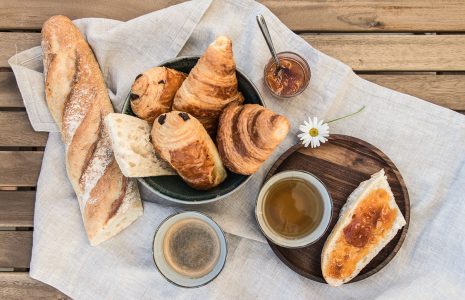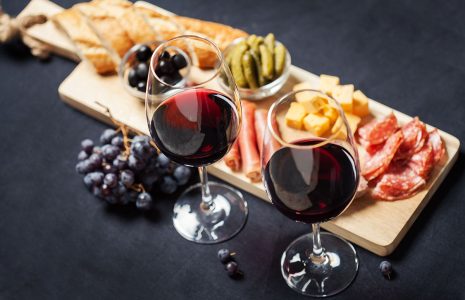
Breakfast, Lunch & Dinner – The Everyday French Cuisine
Bonjour and welcome to our delightful culinary adventure through the flavours of France! Get ready to tantalize your taste buds and embark on an adventure through breakfast, lunch and dinner as we take you through their everyday cuisine.
Oh, what a journey you’ll have as we talk pastries, sumptuous cheeses and delectable desserts, showcasing some of the best French dishes.
So grab your pen, and paper, ready to pull together a shopping list as we teach you to dine like the French.
The Everyday French Cuisine
Breakfast – Petit Déjeuner
Imagine you’re in Paris having breakfast – what are you eating? You’re probably imagining buttery pastries, and rich coffee from a little cafe that’s a bit bougie. Unfortunately, this isn’t entirely accurate.
Of course, the French love a good croissant, but not every single morning!
For the French, breakfast is considered the least important meal of the day, so is usually light and simple. A typical breakfast will include sweet, carb-heavy foods. In some areas of France, which are more rural, breakfasts may include some food which has been produced on the farm, such as salami and cheese.
Typical French Breakfast foods include:
- Coffee
- Orange Juice
- A viennoiserie (this can be a croissant, pain au chocolat or pain au raisin)
- Baguette with butter and jam. This is known as “tartines”.
Lunch – Déjeuner
Now lunch is where it starts to get exciting. Lunch is, in fact, considered the most important meal of the day and, therefore, is the heaviest.
A usual French lunch will start with an appetiser such as a soup, mixed salad or pate, a nice way to start off a three-course lunch.
Check out our collection of delicious pates by Castaing for your lunch!
Next will be a type of meat, either, beef, chicken or fish. This is normally served with a carb, such as potatoes or pasta, accompanied by an array of vegetables. Then, of course, it wouldn’t be a French meal without something sweet, such as a chocolate mousse, to round it off.
Lunch foods to include:
Starter – this can be a salad, soup or pat.
Main dish – meat/fish and vegetables, rice, potatoes or pasta
Cheese – a platter with several types of cheese
Dessert – chocolate or fruit
Coffee – all French people end their lunch with a “café”.
Optional: a glass of wine.
Dinner – Diner
Dinner can vary a lot for the French, depending on the season, day of the week or even the meals they’ve had that day. For example, Sunday dinner, which is usually had with extended family, will often include more courses. The French will also schedule their dinners later, between 7:30-8:30, hence the big lunch!
A French dinner would usually begin with a starter/appetizer such as escargot or even foie gras on toast.
If you fancy recreating your own French starter, our collection of foie gras is a great place to start, take a look for yourself here.
The main dish can be a combination of fish or meat with vegetables. Other main dishes would also include Boeuf Bourguignon or Cassoulet, both of which are traditional French dishes.
Check out our range of La Belle Chaurienne products for Cassoulets and Boeuf Bourguignon that are easy to prepare and ready to eat.
A French dessert will still be very simple and light, such as a mousse or fruit.
Wine also plays a big role at dinner times for the French, so much so that they even have a saying – “repas sans vin, repas chagrin” – which means “ a dinner without wine, is a sad dinner”.
Dining Like The French – The Do’s & The Don’ts
So now you know the what, when and why of French dining, it’s time to get an understanding of the do’s and the don’ts when dining like the French.
Here are just a few of the top points to remember:
- No fizzy or soft drinks when eating (unless it’s water). There may be times when having drinks other than wine is acceptable during a meal but soft drinks and even cocktails are regarded as appetizers or for after meals.
- No TV when eating. Specifically in the evenings, French TV is scheduled to start after dinner as it is thought to be impolite to be watching TV while eating dinner, especially if you are with the family.
- Refill others’ glasses before your own. It is simply polite to top up other people’s drinks before your own and is a common rule of thumb when dining.
- Don’t spread Foie Gras. Foie gras is meant to sit on bread/toast.
- No Ketchup – unless it’s for Fries. In France, it is very important to enjoy the full flavours of every meal, so adding ketchup to any dish is simply not done.
Enjoy!
From simple breakfasts to three-course lunches and family dinners, French cuisine is all about enjoying the flavours of food as they come, with no distractions. Whether that be by a great wine to accompany the dish or simply turning the TV off so that you can enjoy the food and the company.
If you want to learn more about French cuisine or how to serve dishes like the French, our blog post called, Serve Like The French – 5 Great Ways To Serve Foie Gras, is great for learning how to become a French cuisine connoisseur!




